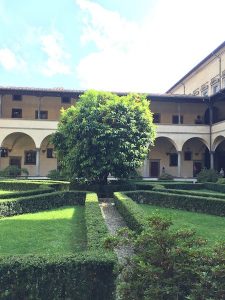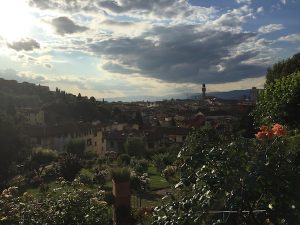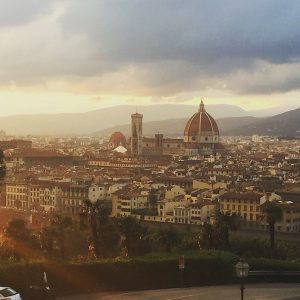“Grazie mille,” I said to our waiter as I left the restaurant and stepped out into the warm cobblestone streets of Florence. A thousand thanks. I had at least a thousand things to be thankful for on my last evening in Italy, but mostly, I was thankful for Mediterranean sunsets. Perhaps that’s why I felt compelled to cross the Arno River and hike up to Piazzale Michelangelo, where the entire city is visible. There, I watched the sun flood buildings with gold-copper rays as it struck the terracotta shingles of the Duomo di Firenze, kissing it goodnight before slipping behind the Tuscan hills for the last time.
I didn’t always know Italy was going to feel more like home than the one I came from, but that’s how it worked out. When we first landed, I thought living in Florence was going to be tough. Separated from home by a seven-hour time difference and the world’s second largest body of water, I was sure I’d feel very small and very alone. And yet, I never did. I felt comfortable.
It’s a cozy place, Florence. Sitting in the bottom of a Tuscan floodplain, the people are just as down to earth as the city. There is friendliness, amiability, in Italians that transcends language barriers. You want to like them. Scratch that – you already do. Sitting at a restaurant eating “tagliatelle” or sipping on a “bellini”, it’s easy to lose yourself in their conversations. Just like their words, relationships have depth and weight. One moment you’re talking about weekend trips, the next, you’re discussing thematic elements of Renaissance paintings. And they’re humble about it, too. They switch between the mundane and the profound casually, as if they’re asking for a glass of water.
It’s a subtle sophistication, an impressive intellectual clout, and it leaves you aching for more. Every day I dreaded coming back to the stale conversations of my old life. I was now fully aware of the capacity of language, aware that beautiful things could be said, and said often.
More than that, I was dumbfounded by how much there was to be said about everything. Castles, bridges, streets, and statues; there was a story for all of them, and for all of them, a story. As an American, I’ve hardly set foot in anything over one hundred years old. In Florence, it’s completely possible to find landmarks well over one thousand years old. And yet, none of it feels out of place. Here, the historic and the contemporary coexist. Gelaterias sit comfortably next to ancient basilicas. Vespas cross century-old bridges. Open markets crop up in ancient piazzas. The present suits the past; it respects it.
It’s a good thing, too, because the past inadvertently prevented me from getting lost. Historic landmarks make navigating a breeze. There’s the Palazzo Vecchio and Santa Croce, there’s the Ponte Vecchio and the Arno River that flows lazily beneath it, there’s the Piazza della Repubblica and the Basilica di Santa Maria Novella, and of course, there’s the Duomo, which anchors everything. With a general knowledge of these waypoints, you can easily make it from one side of the city to the other in fifteen minutes. But you won’t. You’ll be too busy staring up at everything and smiling.
That’s the position I often found myself in while abroad: smiling. Smiling because I was already more familiar with Florence than my hometown. Smiling because with every turn of a corner, there’d be something so visually striking that I’d have to stop to appreciate it. Smiling because fresh food was accompanied with fresh conversation in restaurants and open markets alike. Smiling because I, too, was in some way a part of it all.
So there I stood, on my final night in Florence, watching the sun dip its ruddy orange head beneath the horizon for the last time, and I was smiling. Because I knew it wasn’t really the last time. I’d be back. For now, though, I had only one thing to say as I looked down on the city that changed my life irrevocably.
Grazie mille. A thousand thanks.
Jack Sherman, Carroll University, Summer Special Program at ISI Florence: “Revising Italy: Travel Writing and the Italian Tradition”.




